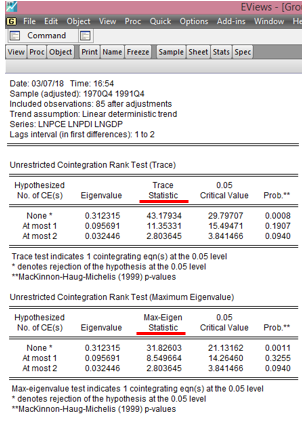After unit root testing, what next?
In the Part 1 of
this structured tutorials, we discussed Scenario 1: when the series are
stationary in levels that is I(0)
series and Scenario 2: when they are stationary at first difference. In the
first scenario, it implies that any shock to the system in the short run
quickly adjusts to the long run. Hence, only the long run model should be
estimated. While for the second
scenario, the relevance of the variables in the model is required, therefore there
is need to test for cointegration. If there is cointegration, specify the
long-run model and estimate VECM but if otherwise, specify only the short-run
model and apply the VAR estimation technique and not VECM. In today’s lecture
we consider the third scenario of when the variables are integrated of
different orders.
Scenario
3: The series are integrated of different orders?
1.
Should in case the series are integrated
of different orders, like the second scenario, cointegration test is also
required but the use of Johansen cointegration test is no longer valid.
2.
The appropriate cointegration test is
the Bounds test
for cointegration proposed by Pesaran, Shin and Smith (2001)
4. Similar to scenario 2, if series are not
cointegrated based on Bounds test, we are expected to estimate only the short
run. That is, run only the ARDL model (where variables are neither lagged nor
differenced). It is the static form of the model.
5.
However, both the long run and short run
models are valid if there is cointegration. That is, run both ARDL and ECM
models.
Bounds
Cointegration Test in EViews
In this example,
we use the Dar.xlsx data on Nigeria from 1981 to 2014 and the variables are the
log of manufacturing value-added (lnmva),
real exchange rate (rexch) and gross
domestic growth rate (gdpgr). The
model examines the effect of real exchange rate on manufacturing sector while
controlling for economic growth.
Note: Cointegration test should be performed on the level
form of the variables and not on their first difference. It is okay to also use
the log-transformation of the raw variables, as I have done in this example.
Step
1: Load
data into EViews (see video on how to do this)
Step
2: Open
variables as a Group data (see video on how to do this) and save under a new
name
Step
3:
Go to Quick >> Estimate Equation >> and specify the static form of the model which is stated
as: lnmvat = b0 + b1rexcht + b2gdpgrt + ut in the Equation Estimation Window
Step 4: Choose
the appropriate estimation technique
Click on the drop-down button in
front of Method under Estimation settings and select ARDL
– Auto regressive Distributed Lag Models
Step 5: Choose
the appropriate maximum lags and trend specification
The lag length must be selected
such that the degrees of freedom (defined as n - k) must not be less
than 30. The Constant option under the Trend specification is also selected.
Step 6: Choose
the appropriate lag selection criterion for optimal lag
Click on Options tab, then
click on the drop-down button under Model Selection Criteria and select
the Akaike info Criterion (AIC), then click Ok.
Step 7: Estimate
the model based on Steps 3 to 6
Step 8: Evaluate
the preferred model and conduct Bounds test
The hypothesis
is stated as:
H0:
no cointegrating equation
H1: H0
is not true
Rejection of the null hypothesis is at the relevant
statistical level, 10%, 5% level, 1%.
a. Click on View on the
Menu Bar
b. Click on Coefficient
Diagnostics
c. Select the Bounds
Test option
The following
result is displayed below:
Here is the
EViews result on the ARDL Bounds Test of lnmva, rexch and gdpgr:
 |
| EViews: ARDL Bounds Test Result Source: CrunchEconometrix |
Step
9: Interpret your result appropriately using the following decision criteria
The three
options of the decision criteria are as follows:
1. If
the calculated F-statistic is greater
than the critical value for the upper bound I(1), then we can conclude
that there is cointegration that is there is long-run relationship.
2. If
the calculated F-statistic falls
below the critical value for the lower bound I(0) bound, then we
conclude that there is no cointegration, hence, no long-run relationship
3. The
test is considered inconclusive if the F-statistic
falls between the lower bound I(0) and the upper bound I(1).
Decision: The obtained F-statistic
of 0.6170 falls below the lower
bound I(0), hence, we will
consider only short run models since the variables show no evidence of a
long-run relationship as indicated by the results from the Bounds test.
[Watch video on how to conduct Bounds
test for cointegration in EViews]
If there are
comments or areas requiring further clarification, kindly post them below….






